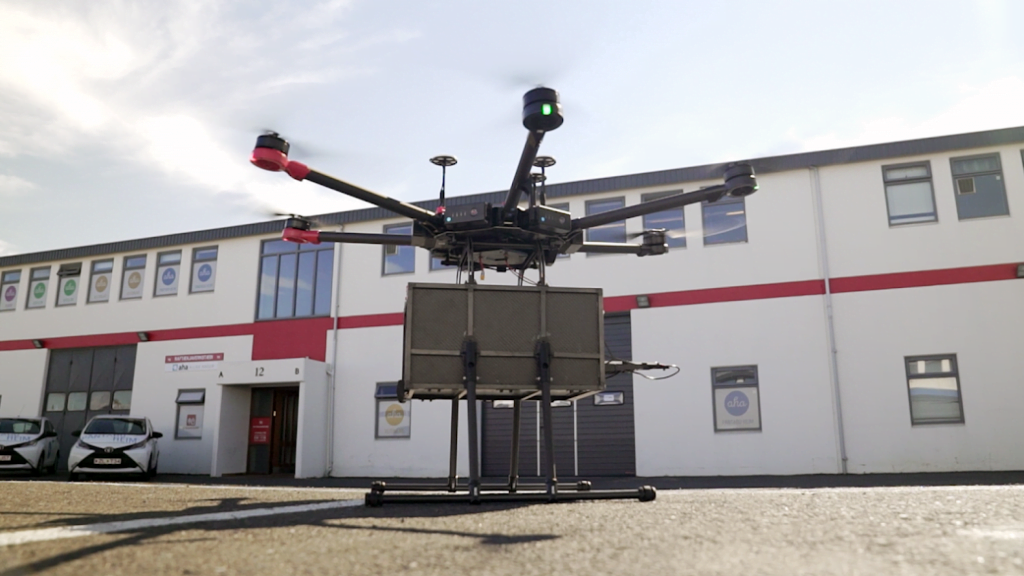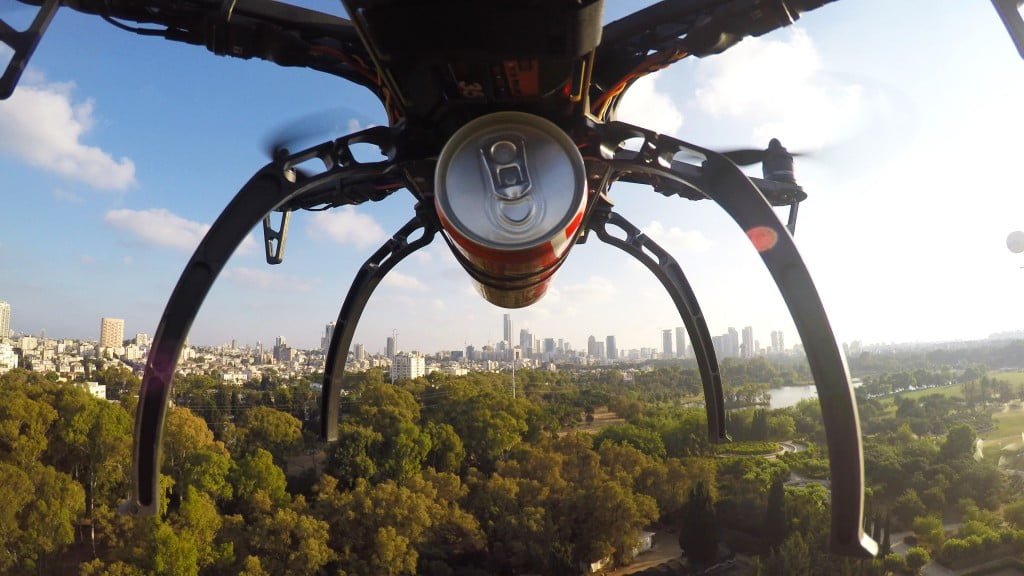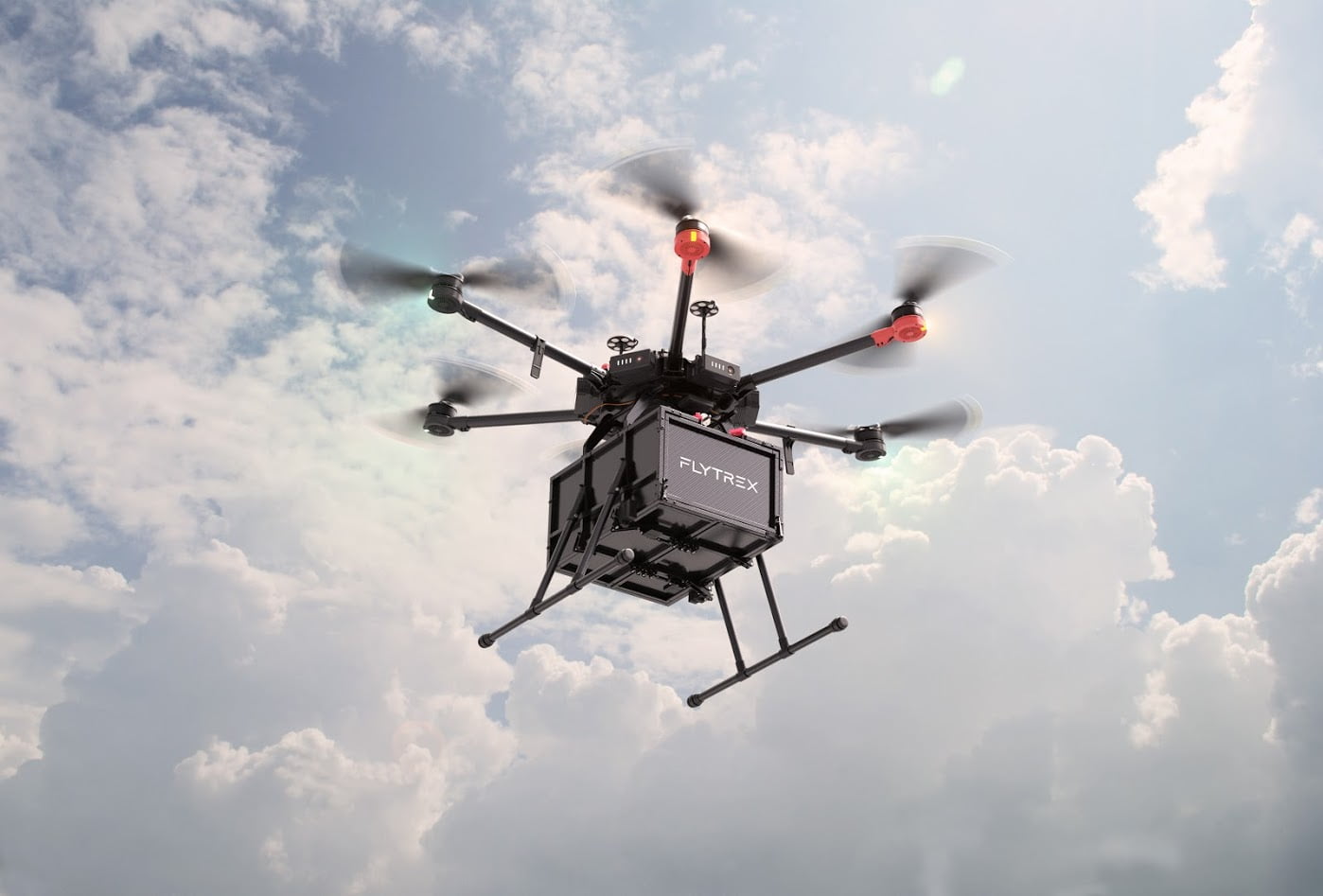It’s a bird…It’s a plane…It’s a drone delivering my four-cheese pizza.
That scenario (minus the Superman reference) may soon become a reality due to cutting-edge technology developed by an Israeli logistics company seeking to make backyard drone drops of food orders and retail goods a real thing in the coming years.
Flytrex, an on-demand service based in Tel Aviv which seeks to enhance the efficiency of food and consumer good deliveries – whether it’s sushi, a new phone, or a six-pack of beer – says it can manage these drops in as little as four-and-a-half minutes to some of the most remote locations.
The company has so far been working on its delivery system mainly in Iceland, through AHA, one of the country’s largest e-commerce companies. But it is looking to broaden its horizons.

Flytrex launched its first ongoing drone delivery operation in Reykjavík, Iceland, using DJI’s Matrice 600 drones to deliver food from the AHA warehouse to a designated location. Courtesy
In May, Flytrex was selected to participate in an Unmanned Aircraft System (UAS) Integration Pilot Program established by the Federal Aviation Administration (FAA) to expand testing of commercial drone operations, alongside tech giants like Google, Intel, and Uber. The program allows 10 state, local, and tribal governments to “partner with private sector entities, such as UAS operators or manufacturers, to accelerate safe UAS integration,” the FAA says.
The selected locations across the US for the participating companies include Raleigh, North Carolina; San Diego, California; Reno, Nevada; Durant, Oklahoma (Choctaw Nation of Oklahoma); Topeka, Kansas; and Memphis, Tennessee.
The program is significant for the drone tech company as it brings the firm closer to its goal of breaking into the United States market. Though it’s been accepted to the pilot program, Flytrex CEO and co-founder Yariv Bash tells NoCamels, the company is still finalizing the details with the FAA.
“We should be flying drones on real deliveries by the end of the year,” he estimates. If that happens, Bash will be closing out 2018 with a bang. His other project, the Israeli startup SpaceIL, which he co-founded in 2010 with Kfir Damari and Yonatan Weintraub, recently announced that it plans to launch a spacecraft to the moon by December and land in February 2019. If it happens, Israel will become the fourth country in the world to complete a controlled moon landing.
As for controlled drone landings, Bash says Flytrex is “going to change the way we consume goods,” adding that it was an exciting time for the company.
“The same way that cars started [by] going on dirt roads and today we have traffic lights and signs, we’ll see a similar evolution in the air traffic management needs for all the different drones – delivery companies, inspection drones, first responders and others who will share the same airspace,” he explains.
The FAA has been working with NASA (National Aeronautics and Space Administration) to develop a universal air-traffic management system for drones which will only be completed in 2020, which Bash says is something “we look forward to.”
Flytrex in Iceland
Bash founded Flytrex in 2013 with business partner Amit Regev, who was Bash’s flatmate while he was working for SpaceIL.
Flytrex began working with Iceland’s AHA last year in the capital city of Reykjavik as part of a limited trial phase. The project was successful and efficient, Bash noted, only taking four-and-a-half minutes for a Flytrex drone to travel two miles from the AHA warehouse to a designated spot across the city, which is separated by a river. A human driver then completes the delivery. The whole process takes about 20 minutes.
SEE ALSO: ‘Flytrex Sky’ Personal Delivery Drone Will Ship Goods To Your Location Within Minutes
Flytrex, which provides drone delivery management through the cloud, but does not build actual drones, plans to phase in more hardware as part of the program over the next two years.
Sign up for our free weekly newsletter
SubscribeIt currently offers three types of delivery services with different drones: the Flytrex Sky II, based on the QAV500 by the Florida-based company Lumenier, which can deliver small parcels of up to 450 grams (about 1 pound) to distances of up to 7 km (4.3 miles); the Flytrex Fox, based on the quadcopter Matrice 100 by Chinese company DJI (Dà-Jiāng Innovations), which can deliver parcels weighing up to 800 grams (1.7 pounds) to distances of up to 8 km (4.9 miles); and the Flytrex Mule, based on the Matrice 600 Pro, also by DJI, which can deliver large parcels of up to 3kg to distances of up to 10 km (6.2 miles). The latter has an in-air release mechanism that offers the “ability to gently lower packages without landing, down-facing radar for safe delivery and more.”
AHA currently flies 13 routes around Reykjavik delivering packages of everything from hamburgers to smartphones, with the Matrice 600 Pro.
“You’re not going to see a refrigerator flying above your house any time soon,” Bash told the BBC last month, but “87 percent of packages weigh less than six pounds anyway,” he tells NoCamels.
The Matrice 600 drones can complete about 20 deliveries a day, but the number is expected to grow substantially, to over 100, Bash says.
The groundbreaking system is life-changing, he says, “like moving from Nokia to [the] iPhone.”
How it works
While Flytrex controls the logistics of the drone with its advanced technology, how do customers ensure that the delivery arrives at their designated location, whether a backyard or a designated public park? Bash says an app connected to the drone can be uploaded to the customer’s phone, who, with the press of a button, can follow the drone’s journey.
One of Bash’s biggest reasons for expansion, besides the importance of providing efficient service, is the focus of delivery to more suburban and remote locations.
When asked if drone delivery will take jobs from human employers, Bash is quick to answer that it will probably create more jobs, particularly in the food industry. Bash notes that while a lot of delivery companies focus on urban and city centers, suburb dwellers are just as interested in the service and yet not easily accommodated.
“We are starting with food because it’s a time critical order,” Bash explains, “I think people will appreciate the food coming faster and it will be cheaper for the consumer. Now you can also create a lot more jobs with food delivery because most potential locations are not used.”
Drone delivery, he says, is also a lot safer than the human courier on the back of a scooter. The drone delivery box is also stabilized by gravity, even though the package hovers above the delivery point, he adds.
SEE ALSO: Delivering The Goods: Israel Leads The Way In Drone Innovation
The difference, Bash is quick to add, is that the delivery person doesn’t have to risk his or her life getting on or in a vehicle.
“Every drone that delivers goods will save lives,” he says.
Related posts

Editors’ & Readers’ Choice: 10 Favorite NoCamels Articles

Forward Facing: What Does The Future Hold For Israeli High-Tech?

Impact Innovation: Israeli Startups That Could Shape Our Future






Facebook comments